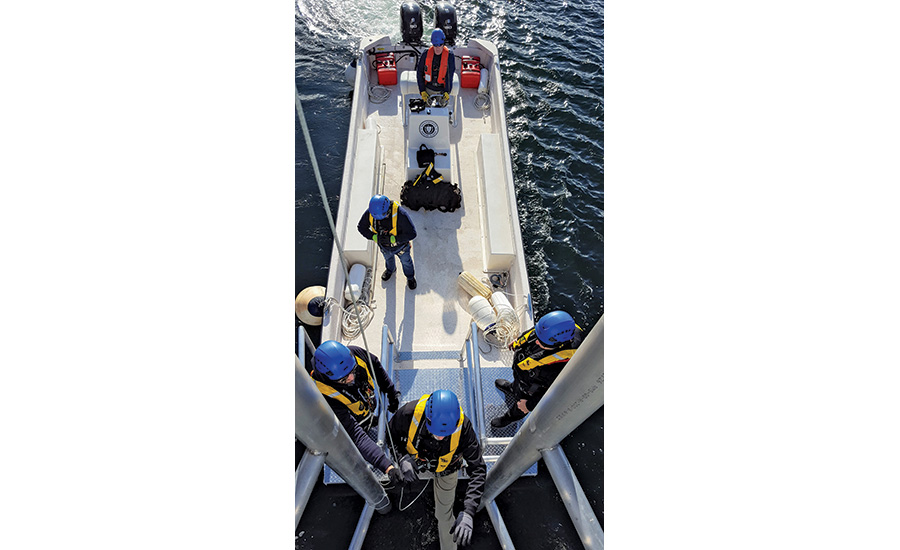With construction of the Massachusetts Maritime Academy’s new offshore wind training facility just completed and classes under way, climbing structures for on-water crew transfer training and indoor work at height, are compelling to students. “This will be the first U.S. facility to include all five components of Global Wind Organization training, including sea survival,” says Tom Pham, academy project officer.
The push for the $1.73-million facility on Cape Cod to meet training standards of GWO—a Denmark-based group of offshore wind energy market participants—comes as sector growth momentum along the eastern seaboard drives demand for a trained craft and technical workforce.
As eight East Coast states—particularly Massachusetts, New York, New Jersey and Virginia—push forward to install offshore wind, “developers, turbine manufacturers and unions all have a need for workforce training because this is a new industry to us,” says Michael Burns, academy director for maritime and professional training.
The crew transfer facility on the academy pier in Buzzard’s Bay comprises a 12-ft-wide by 7-ft-long by 10-ft-high lightweight aluminum gangway structure with a 20-ft-high by 9-in-wide ladder. It is designed to simulate personnel boarding a transfer boat and climbing a ladder from the vessel onto a stationary turbine platform. There also is a newly constructed indoor climbing facility.
“Basic safety training will be required for all offshore wind workers who are out on the water,” says Nils Bolgen, offshore wind program director at the Massachusetts Clean Energy Center in Boston, which provided $500,000 to build the training facility. “The key missing component in the U.S is crew transfer training,” he says.
“That’s where the accidents happen, when somebody is going from boat to boat or a floating structure to a fixed structure,” says David Borrus, business manager for Pile Drivers union Local 56, which includes divers. Workers will join the first 48-hour, four-week program, in partnership with global safety training provider Relyon Nutec, which will include 12 trainees per class.
The academy expects to train 60 by next May, also including cadets, electricians and welders.
Local Access
Local 56 workers are set to help build the $2.8-billion, 800-MW Vineyard Wind offshore wind farm off the Massachusetts coast, the first in the U.S. at utility scale, even as its construction start now is delayed to next year with an unexpected—and controversial—federal permitting delay in August.
Project developers already have started the $2-million Windward Workforce Fund to recruit and train state residents for offshore wind jobs.
“We are collaborating with MassCEC, educational partners and workforce development institutions to set up and help fund required safety and technical training programs … to ensure local residents have access to the industry,” says Jennifer Cullen, Vineyard Wind permitting and outreach specialist.
Vineyard also is negotiating a project labor agreement with the state Building Trades Council to “determine how trades will address unique conditions of working in this new industry, including need for multiskilled workers, offshore stays of two-plus weeks and shift patterns required,” she says.
GE Renewables General Manager Rainer Broering said that with 22.5 GW of offshore wind power potential in the U.S and with GE set to deploy in two east coast markets, Haliade-X, the world’s largest offshore wind turbine, he sees more skilled jobs beyond the one- or two-year construction timeline.
New Jersey Gov. Phil Murphy (D)’s enthusiasm for offshore wind as a more cost-effective clean energy source prompted him on Nov. 19 to boost the state target to 7,500 MW by 2035, up from 3,500 MW by 2030.
The sector also is looking on campus for its workforce.
MassCEC is funding offshore wind technician certification training at several state community colleges and at the University of Massachusetts-Amherst. Tufts University established this fall a new master’s degree in offshore wind energy engineering, the first U.S. graduate program dedicated to offshore wind structural and geotechnical design.
Rhode Island Gov. Gina Raimondo (D) announced in April that Danish wind developer Orsted U.S. and utility Eversource, partners in the 880-MW Sunrise offshore wind project, pledged $4.5 million to support sector education and supply chain development in the state.
Of that, $3 million is for University of Rhode Island programs. The firms also committed $10 million to create a national workforce training center with unions and Suffolk County Community College in New York.
Ian Baring-Gould, technology deployment manager for the U.S. National Renewable Energy Lab, told attendees at an industry conference last month in Boston that a regional approach to workforce development is key to avoid having unneeded training programs that will fail.




Post a comment to this article
Report Abusive Comment